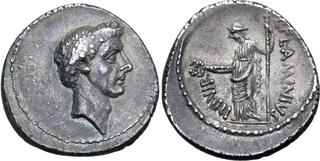Lot description:
Julius Caesar AR Denarius. Rome, 43 BC. L. Flaminius Chilo, moneyer. Wreathed head of Caesar to right / Goddess (Pax or Venus?) standing to left, holding caduceus and sceptre; L • FLAMINIVS downward to right, IIII • VIR upward to left. Crawford 485/1; CRI 113; BMCRR Rome 4201-2; RSC 26. 3.78g, 19mm, 8h.
Good Extremely Fine; attractive cabinet tone, a wonderful portrait of Caesar.
This coin published in Richard Schaefer's Roman Republican Die Project (RRDP), binder 12, p. 14, available online at: http://numismatics.org/archives/ark:/53695/schaefer.rrdp.b12#schaefer.rrdp.b12_0024;
Ex Roma Numismatics Ltd., Auction XXIII, 24 March 2022, lot 769 (hammer: GBP 10,000);
Ex Viggo Collection, Classical Numismatic Group, Triton XXII, 8 January 2019, lot 946;
Ex JD Collection of Roman Republican Coins, Numismatica Ars Classica, Auction 72, 16 May 2013, lot 494;
Ex Numismatica Aretusa, Auction 2, 13 May 1994, lot 294.
In the years of his supremacy, Caesar had amassed unprecedented power by corrupting the institutions of the old Republic to his own requirements. First appointed Dictator in 49 BC by the Praetor (and future Triumvir) Marcus Aemilius Lepidus, possibly in order to preside over elections, Caesar resigned his Dictatorship within eleven days but in 48 BC he was appointed Dictator again, only this time for an indefinite period, and was also given permanent tribunician powers making his person sacrosanct and allowing him to veto the Senate. In 46 BC he was appointed Dictator for ten years, and he gave himself quasi-censorial powers under the mantle of 'Prefect of the Morals', enabling him to fill the Senate with his partisans who duly voted him the titles of Pater Patriae and Imperator. He increased the number of magistrates who were elected each year, thus allowing him to reward his supporters, and in October 45 BC, having served in the unconstitutional role of Sole Consul for that year, Caesar resigned his consulship and facilitated the election of two successors for the remainder of the year - theoretically restoring the ordinary consulship, but in practice submitting the Consuls to the Dictatorial executive - a practice that later become common under the empire. In February 44 BC, one month before his assassination, Caesar was appointed Dictator for life.
More followed; he was given the unprecedented honour of having his own likeness placed upon the Roman coinage, his statue was placed next to those of the kings, he was granted a golden chair in the Senate, and was permitted to wear triumphal dress whenever he chose. Then, at the festival of the Lupercal, Marc Antony presented Caesar with a royal diadem, and attempted to place it on his head. Yet for all these hideous affronts to the ancient institutions of the Republic and the sensibilities of the Roman people, perhaps his most egregious reform was the law he passed in preparation for his planned campaign against the Parthian Empire. Realising that his absence from Rome would impede his ability to install his own men in positions of power and that therefore his back would be exposed while away from the city, Caesar decreed that he would have the right to appoint all magistrates in 43 BC, and all consuls and tribunes in 42 BC, thus at a stroke transforming the magistrates from being representatives of the people to being representatives of the dictator.
Struck after Caesar's assassination, this coin marks a departure from the portraiture on the coinage minted during his lifetime. Rather than the veiled head of Caesar the dictator, depicted instead is the wreathed head of the soon-to-be deified adoptive father of Octavian. This depiction of Caesar by Flaminius Chilo appears to be heavily influenced by Octavian's concerted attempts in the aftermath of Caesar's death to rehabilitate his image in the eyes of many of those at Rome who had developed concerns surrounding his increasing power and also, perhaps more cynically, to reinforce Octavian's own legitimacy as his heir.
Estimate: 8000 GBP |  |